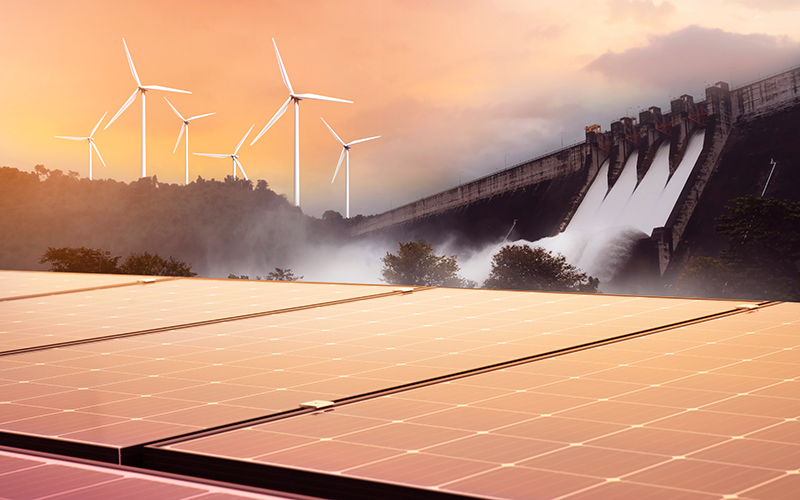In the quest for a greener and more sustainable future, the spotlight is firmly on renewable energies. Hence, we shall now take the EET series deep into the world of renewable energies, unpacking their various technological facets, their burgeoning significance in our energy landscape, the diverse sectors they impact, and the essential skills needed to thrive in this exciting and rapidly evolving field.
The different types of renewable energies
Renewable energies encompass an array of sources, each harnessing nature’s forces to generate clean power. Let’s delve into the technologies behind these sources, as well as some of the potential roles behind them:
- Solar energy: Photovoltaic (PV) cells, often made of silicon, convert sunlight into electricity using the photovoltaic effect. Concentrated Solar Power (CSP) plants focus sunlight onto a heat-absorbing fluid, which generates steam to drive turbines. A solar photovoltaic engineer designs and develops solar panel systems for residential, commercial, or industrial use. They work on optimising energy output, assessing site feasibility, and ensuring proper system integration.
- Wind energy: Wind turbines comprise rotor blades that capture kinetic energy from the wind. This energy rotates the rotor connected to a generator, producing electricity. A wind turbine technician is responsible for the installation, maintenance, and repair of wind turbines. They troubleshoot mechanical and electrical issues, ensuring the efficient operation of wind farms.
- Hydroelectric energy: Large dams or run-of-the-river systems channel water through turbines. The gravitational energy of falling water is converted into mechanical energy, which is then transformed into electricity. A hydropower plant manager oversees the operations of hydroelectric facilities. They manage maintenance schedules, monitor power generation, and ensure compliance with safety and environmental regulations.
- Geothermal energy: Geothermal power plants tap into the Earth’s internal heat by harnessing steam or hot water from deep beneath the surface. This steam drives turbines connected to generators. A geothermal reservoir engineer studies underground reservoirs to optimise geothermal energy extraction. They analyse reservoir performance, assess potential sites, and develop strategies to enhance energy production.
- Biomass energy: Biomass is converted into biofuels (ethanol, biodiesel) or burned directly to produce heat or electricity. Anaerobic digestion and gasification are also utilised to extract energy from organic matter. A bioenergy research scientist focuses on developing advanced biofuels and biomass conversion technologies. They work on optimising biofuel production processes, improving feedstock quality, and conducting research to enhance efficiency.
The growing importance of renewable energy
Renewable energies are not just a trend; they are a necessity in combating climate change and ensuring a sustainable energy future. By reducing greenhouse gas emissions and decreasing our reliance on finite fossil fuels, renewables are pivotal in achieving global environmental goals and fostering energy security.
Renewable energies span multiple sectors, driving change in various industries, for instance:
- Residential: Rooftop solar panels and small wind turbines empower homeowners to generate their own energy. Smart home technologies and energy storage solutions optimise energy use.
- Commercial and industrial: Companies integrate renewable systems into their operations, benefiting from lower energy costs and fulfilling corporate social responsibility.
- Utilities: Utility-scale solar farms and wind projects feed substantial amounts of clean energy into the grid. Energy storage technologies are crucial for ensuring a consistent power supply.
- Transportation: Electric vehicles, charged by renewables, are reshaping the transportation sector, reducing emissions and reliance on fossil fuels.
The close-knit nature of renewable energies and the various different sectors it spans allow for a single skill set and knowledge base to be applied to a considerable amount of different roles and careers.
The importance for students
For students and aspiring professionals, the renewable energy sector presents a wealth of opportunities across diverse domains:
- Engineering: Engineers design, construct, and optimise renewable energy systems. Skills in system integration, materials science, and energy storage technologies are essential.
- Research & Development: Innovators explore advanced materials, energy storage solutions, and cutting-edge technologies to enhance the efficiency and viability of renewable energy sources.
- Policy and advocacy: Professionals in this sphere craft policies that promote renewables and advocate for sustainable energy practices. Expertise in energy economics and environmental law is valuable.
- Environmental science: Experts assess the ecological impact of renewable energy projects and devise strategies for responsible implementation. Strong analytical and modelling skills are crucial.
Something to keep in mind
Renewable energies are not just a trend but a transformative force shaping our future. From state-of-the-art technologies to diverse career pathways, the renewable energy sector is a realm of innovation and purpose. By developing the right skills and embracing the opportunities it offers, individuals can play a pivotal role in driving us toward a cleaner, more sustainable world.




